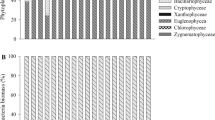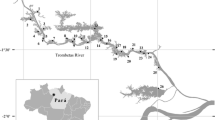Abstract
We evaluated temporal trends in zooplankton functional diversity (functional richness—FRic, evenness—FEve divergence—FDiv, and Community-Weighted Means—CWM) in 12 habitats of the Upper Paraná River floodplain (Brazil) over 16 years (2000–2016) and their relationships with environmental predictors (chlorophyll-a, water depth, and turbidity). We hypothesized that different environmental drivers affect zooplankton's functional component in a distinct way. We predicted that: (i) FRic is positively related to increases in chlorophyll-a concentration and turbidity associated with impacts of damming on the floodplain and depth. (ii) FEve is negatively related to increases in chlorophyll-a concentration and turbidity, and positively related to depth. (iii) FDiv is negatively related to the increase in chlorophyll-a, depth, and turbidity. (iv) Finally, we asked how do each of the traits change the functional indexes and their relation to environmental predictors. FRic and FEve fluctuated oppositely and cyclically every five years. FDiv showed a trend similar to that of FRic. However, between 2005 and 2010 FDiv only decreased. All functional diversity indexes were explained by temporal variability, depth, and chlorophyll-a concentration. However, the influence of each variable was different for each component of functional diversity. For CWM, turbidity was negatively associated with life span and positively associated with predator escape, and type of reproduction, while predator escape and feeding type were negatively associated with depth. We highlight that, in order to maintain the drivers of zooplankton functional diversity (food availability, turbidity, and depth), it is extremely important to guarantee the floodplain ecosystem's original state of functionality.






Similar content being viewed by others
References
Abonyi A, Horváth Z, Ptacnik R (2018) Functional richness outperforms taxonomic richness in predicting ecosystem functioning in natural phytoplankton communities. Freshw Biol 63:178–186
Affonso AG, Queiroz HL, Novo EMLM (2015) Abiotic variability among different aquatic systems of the central Amazon floodplain during drought and flood events. Braz J Biol 75:60–69
Agostinho AA, Thomaz SM, Gomes LC (2004) Threats for biodiversity in the floodplain of the Upper Paraná River: effects of hydrological regulation by dams. Ecohydrol Hydrobiol 4:255–268
Agostinho AA, Bonecker CC, Gomes LC (2009) Effects of water quantity on connectivity: the case of the upper Paraná River floodplain. Ecohydrol Hydrobiol 9:99–113
Alan J (1976) Life history patterns in zooplankton. Am Nat 110:165–180
Arrieira RL, Alves GM, Schwind LTF, Lansac-Tôha FA (2015) Local factors affecting the testate amoeba community (Protozoa: Arcellinida; Euglyphida) in a neotropical floodplain. J Limnol 74:444–452
Barnett AJ, Finlay K, Beisner BE (2007) Functional diversity of crustacean zooplankton communities: Towards a trait-based classification. Freshw Biol 52:796–813
Bomfim FF, Braghin LSM, Bonecker CC, Lansac-Toha FA (2018) High food availability linked to dominance of small zooplankton in a subtropical floodplain. Int Rev Hydrobiol 103:26–34
Bonecker CC, Lansac-Toha FA, Rossa DC (1998) Planktonic and non-planktonic rotifers in two environments of the Upper Parana River floodplain, state of Mate Grosso do Sul, Brazil. Braz Arch Biol Techn 41:447–456
Bortolini JC, Moresco GA, Paula ACM, Jati SJ, Rodrigues LC (2015) Functional approach based on morphology as a model of phytoplankton variability in a subtropical floodplain lake: a long-term study. Hydrobiologia 767:151–163
Bovo-Scomparin VM, Train S, Rodrigues LC (2013) Influence of reservoirs to dispersion and seasonal variation of the phytoplankton community in the Upper Paraná River, Brazil. Hydrobiologia 702:115–127
Bozelli RL, Thomaz SM, Padial AA, Lopes PM, Bini LM (2015) Floods decrease zooplankton beta diversity and environmental heterogeneity in an Amazonian floodplain system. Hydrobiologia 753:233–241
Braghin LSM, Simões NR, Bonecker CC (2016) Hierarchical effects of local factors on zooplankton species diversity. Inland Waters 6:645–654
Braghin LSM, Almeida BA, Amaral DC, Canella TF, Gimenez BCG, Bonecker CC (2018) Effects of dams decrease zooplankton functional b-diversity in river-associated lakes. Freshw Biol 6:1–10
Braz JEM, Dias JD, Bonecker CC, Simões NR (2020) Oligotrophication affects the size structure and potential ecological interactions of planktonic microcrustaceans. Aquat Sci 82:59
Brooks JL, Dodson SI (1965) Predation, body size, and composition of plankton. Science 150:28–35
Brooks TM, Mittermeier RA, da Fonseca GAB, Gerlach J, Hoffmann M, Lamoreux JF, Mittermeier CG, Pilgrim JD, Rodrigues ASL (2006) Global biodiversity conservation priorities. Science 313:58–61
Chaparro G, Marinone MC, Lombardo R, Schiaffino M, Guimarães RA, O’Farrell I (2011) Zooplancton succession during extraordinary drought-flood cycles. A case study in a South American floodplain lake. Limnologica 41:371–381
Cottenie K, Michels E, Nuytten N, De Meester L (2003) Zooplankton metacommunity structure: regional vs. local processes in highly interconnected ponds. Ecology 84:991–1000
Crawley MJ (2007) The R book. Wiley, Chichester
de Bello F, Lavorel S, Díaz S et al (2010) Towards an assessment of multiple ecosystem processes and services via functional traits. Biodivers Conserv 19:2873–2893
Declerck S, Vanderstukken AP, Muylaert AK, De Meester L (2007) Plankton biodiversity along a gradient of productivity and its mediation by macrophytes. Ecology 88:2199–2210
Dornelas M, Magurran AE, Buckland ST et al (2013) Quantifying temporal change in biodiversity: challenges and opportunities. Proc R Soc 280:1–10
Dudgeon D, Arthington AH, Gessner MO et al (2006) Freshwater biodiversity: importance, threats, status and conservation challenges. Biol Rev Camb Philos Soc 81:163–182
Garnier E, Cortez J, Billès G, Navas ML, Roumet C, Debussche M, Laurent G, Blanchard A et al (2004) Plant functional markers capture ecosystem properties during secondary succession. Ecology 85:2630–2637
Gower JC (1966) Some distance properties of latent root and vector methods used in multivariate analysis. Biometrika 53:325–338
Hebert MP, Beisner BE, Maranger R (2016) A meta-analysis of zooplankton functional traits influencing ecosystem function. Ecology 97:1069–1080
Junk WJ, Bayley PB, Sparks RE (1989) The flood pulse concept in river-floodplain systems. Can J Fish Aquat Sci 106:110–127
Junk WJ, Piedade MTF, Lourival R et al (2013) Brazilian wetlands: their definition, delineation, and classification for research, sustainable management, and protection. Aquat Conserv 24:5–22
Kimbell HS, Morrell LJ (2016) Turbidity weakens selection for assortment in body size in groups. Behav Ecol 27:545–552
Laliberté E, Legendre P (2010) A distance-based framework for measuring functional diversity from multiple traits. Ecology 91:299–305
Lansac-Tôha FA, Velho LFM, Higuti J, Takahashi EM (2002) Cyclopidae (Crustacea, Copepoda) from the upper Paraná River floodplain. Brazil Braz J Biol 62:125–133
Lansac-Tôha FA, Bonecker CC, Velho LFM, Simões NR, Dias JD, Alves GM, Takahashi EM (2009) Biodiversity of zooplankton communities in the Upper Parana River floodplain: Interannual variation from long-term studies. Braz J Biol 69:539–549
Laureto LMO, Cianciaruso MV, Menezes DS (2015) Functional diversity: an overview of its history and applicability. Nat Conserv 13:112–116
Litchman E, Ohman MD, Kiørboe T (2013) Trait-based approaches to zooplankton communities. J Plankton Res 35:473–484
Magnusson WE, Grelle CEV, Marques MCM et al (2018) Effects of Brazil’s political crisis on the science needed for biodiversity conservation. Front Ecol Evol 6:1–5
Maia-Barbosa PM, Peixoto RS, Guimaraes AS (2008) Zooplankton in littoral waters of a tropical lake: a revisited biodiversity. Braz J Biol 68:1069–1078
Mason NWH, Mouillot D, Lee WG, Wilson JB, Setälä H (2005) Functional richness, functional evenness and functional divergence: the primary components of functional diversity. Oikos 111:112–118
Mouchet MA, Villéger S, Mason NWH, Mouillot D (2010) Functional diversity measures: an overview of their redundancy and their ability to discriminate community assembly rules. Funct Ecol 24:867–876
Mouillot D, Graham NAJ, Villéger S, Mason NWH, Bellwood DR (2013) A functional approach reveals community responses to disturbances. TREE 28:167–177
Neiff JJ (1990) Aspects of primary productivity in the lower Paraná and Paraguay riverine system. Acta Limnol Bras 3:77–113
Nicolle A, Hansson LA, Brodersen JA, Nilsson P, Brönmark C (2011) Interactions between predation and resources shape zooplankton population dynamics. PLoS ONE 6:1–9
Oliveira AG, Baumgartner MT, Gomes LC, Dias RM, Agostinho AA (2018) Long-term effects of flow regulation by dams simplify fish functional diversity. Freshw Biol 63:293–305
Paggi SJ (1978) Introduccion al estúdio de lós rotíferos. Rev Asoc Cienc Nat Li 9:19–49
Palazzo F, Bonecker CC, Nagae MY (2008) Zooplankton dormancy forms in two environments of the upper Paraná River floodplain (Brazil). Acta Limnol Bras 20:55–62
Pauleto GM, Velho LFM, Buosi PR, Brão AFS, Lansac-Tôha FA, Bonecker CC (2009) Spatial and temporal patterns of ciliate species composition (Protozoa: Ciliophora) in the plankton of the Upper Paraná River floodplain. Braz J Biol 62:517–527
Perbiche-Neves G, Boxshall GA, Previattelli D, Nogueira MG, Rocha CEF (2015) Identification guide to some Diaptomid species (Crustacea, Copepoda, Calanoida, Diaptomidae) of “de la Plata” River Basin (South America). ZooKeys 111:1–111
R Development Core Team (2018) R: A language and environment for statistical computing. R Foundation for Statistical Computing, Vienna
Roberto MC, Santana NF, Thomaz SM (2009) Limnology in the Upper Paraná River floodplain: large-scale spatial and temporal patterns, and the influence of reservoirs. Braz J Biol 69:717–725
Segóvia BT, Pereira DG, Bini LM, Meira BR, Nishida VS, LansacTôha FA, Velho LFM (2015) The role of microorganisms in a planktonic food web of a floodplain lake. Microbiol Ecol 69:225–233
Semenchenko VP, Razlutskij VI, Feniova IY, Aibulatov DN (2007) Biotic relations affecting species structure in zooplankton communities. Hydrobiologia 579:219–231
Simões NR, Lansac-Tôha FA, Velho LFM, Bonecker CC (2012) Intra and inter-annual structure of zooplankton communities in floodplain lakes: a long-term ecological research study. Rev Biol Trop 60:1819–1836
Simões NR, Dias JD, Leal CM, Braghin LSM, Lansac-Tôha FA, Bonecker CC (2013) Floods control the influence of environmental gradients on the diversity of zooplankton communities in a Neotropical floodplain. Aquat Sci 75:607–617
Sodré EO, Bozelli RL (2019) How planktonic microcrustaceans respond to environment and affect ecosystem: a functional trait perspective. Int Aquat Res 11:207–223
Souza Filho E (2009) Evaluation of the Upper Paraná River discharge controlled by reservoirs. Braz J Biol 69:707–716
Strøm K (1946) The ecological niche. Nature 157:375–375
Thomaz SM, Bini LM, Bozelli RL (2007) Floods increase similarity among aquatic habitats in river-floodplain systems. Hydrobiologia 579:1–13
Trevisan GV, Forsberg BR (2007) Relationships among nitrogen and total phosphorus, algal biomass and zooplankton density in the central Amazonia lakes. Hydrobiologia 586:357–365
Villéger S, Mason N, Mouillot D (2008) New multidimensional functional diversity indices for a multifaceted framework in functional ecology. Ecology 89:2290–2301
Violle C, Navas ML, Vile D, Kazakou E, Fortunel C, Hummel I, Garnier E (2007) Let the concept of trait be functional! Oikos 116:882–892
Wickham H (2016) ggplot2: Elegant Graphics for Data Analysis. Springer-ed, New York
Wood SN (2006) Generalized additive models: an introduction with R.
Wood SN (2017) Generalized additive models: an introduction with R (2nd edition).
Acknowledgements
We thank Dr. Reinaldo L. Bozelli, Dr. Anielly G. de Oliveira, Dr. Natália L. dos Santos and Dr. Jean Carlo G. Ortega for discussion of the ideas, and analysis in early versions of this manuscript. The authors acknowledge all NUPELIA staff for the several years of work collecting these data and Programa Ecológico de Longa Duração (PELD—CNPq). We are grateful to the scholarship and productivity grant for provided by the Brazilian National Council of Research and Development (CNPq) and the Coordination for the Improvement of Higher Education Personnel (CAPES).
Author information
Authors and Affiliations
Corresponding author
Ethics declarations
Conflict of interest
The authors declare that they have no conflict of interest.
Additional information
Publisher's Note
Springer Nature remains neutral with regard to jurisdictional claims in published maps and institutional affiliations.
Electronic supplementary material
Below is the link to the electronic supplementary material.
Rights and permissions
About this article
Cite this article
Braghin, L.S.M., Dias, J.D., Simões, N.R. et al. Food availability, depth, and turbidity drive zooplankton functional diversity over time in a Neotropical floodplain. Aquat Sci 83, 10 (2021). https://doi.org/10.1007/s00027-020-00763-7
Received:
Accepted:
Published:
DOI: https://doi.org/10.1007/s00027-020-00763-7




